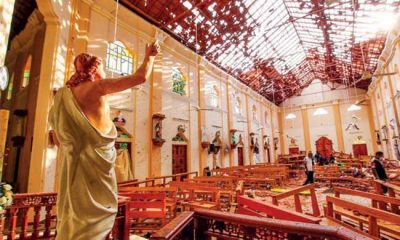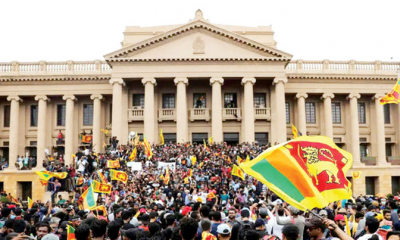Features
SYSTEM CHANGE, NOT IN MY LIFETIME!
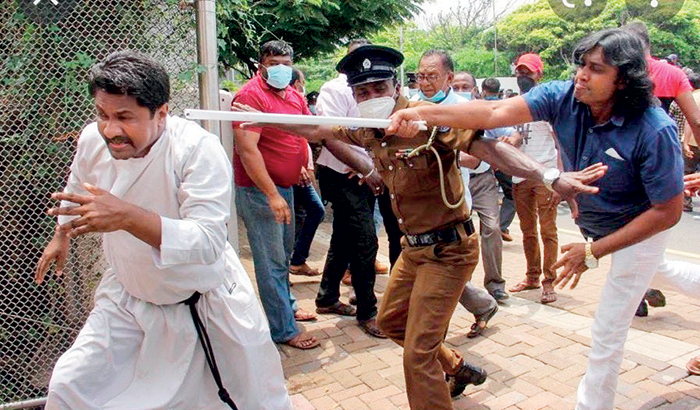
By Sanjeewa Jayaweera
For a short time, the word “system change” was on the lips of many, spoken, shouted, and written with a great deal of passion and hope. The resignation of Mahinda Rajapaksa and his cabinet was expected to be the beginning of the much sought-after and looked forward to system change.
System change may have meant different things to many. Still, there was universal agreement that the way politicians ruled this island nation needed to change. Notably, a new set of people not tainted with allegations of criminal activity, corruption, nepotism, and incompetence should take charge of governing the nation.
It was generally acknowledged that for decades our country had been systematically destroyed and plundered by those we had elected without even a whimper from most of us. A few who understood the precipitous level to which the economy had descended raised the red flag when Gotabaya Rajapaksa(GR) was elected President and implemented shocking changes to the country’s tax regime that significantly reduced government revenue. A debilitating pandemic made the journey to bankruptcy faster than predicted. But, as was the case, too many in the know kept their mouths shut which emboldened those reposed with managing the country’s economy to experiment with reckless policies that defied logic.
Recently in the United Kingdom, Liz Truss, the newly appointed PM, had to eat humble pie and quickly reverse several contentious tax cuts. However, our President, his government, and the Gang of Four steadfastly, stubbornly, and stupidly carried on to destroy our country’s economy.
The straw that broke the camel’s back was the long power cuts and queuing up for days to buy a packet of powdered milk, a cylinder of cooking gas and fuel. The acknowledgment that the country was officially bankrupt, the collapse of the rupee and the steep increase in prices of essential goods impacted every segment of the population, even if the severity was not the same. Finally, it dawned on a few that a stand must be made, and our contempt and displeasure should be expressed outside the confines of our homes, offices, and cocktail parties.
Arising from the discontent, a few English-speaking middle-class professionals organized silent protests in Colombo’s suburbs, holding placards and a candle to express their frustration and anger towards the government. The number of protest locations increased, and the placards were more explicit in condemning GR and his government.Not many, including myself, took these protests seriously and expected them to die naturally. All that changed when the demonstration organized in Mirihana near GR’s home became a battle between the protesters and the police. There was no doubt that “muscle power” had been added to the previously largely middle-class group.
After that, it quickly progressed to setting up a protest site in Galle Face that attracted a sizable segment of youth. The slogan “Gota Go Home” became a rallying cry for the people to express their anger toward the President and his government. The word “Aragalaya” became the catchphrase for the protest movement.
The momentum remained with the protesters, despite the President making certain cosmetic changes by replacing a few individuals in the cabinet, the central bank, and the treasury. The violence that erupted on May 9 changed the country’s mood and political landscape, with Ranil Wickeamesinghe (RW) appointed the PM. The destruction of several SLPP MP’s private residences and the murder of a member of parliament (MP) resulted in many going into hiding and fearing for their lives.
The events of July 9, when thousands of young and not-so-young protesters marched on and forcibly entered the Presidential palace, resulted in GR fleeing the country and subsequently RW being voted by a majority of MPs as the new President. So, if the objective of the “Aragalaya” was only the replacement of the President, PM and the Cabinet, then it has been somewhat achieved. I say somewhat because the incumbent PM and many in the cabinet are still from the previously failed government of GR.
As someone who worked in the private sector for more than a quarter century and was involved in industries such as hotels, manufacturing, and retail, I support the need for an IMF program and its recommended reforms. We need reforms to rectify decades of bad governance and corruption, and to enable these, a stable government and peace in the country is a prerequisite. Many entrepreneurs have articulated that the initial goal of “Gota Go Home” has been achieved, and now his successor should be given time to rebuild the economy and reset the country.
An often cited justification is that the aragalaya was a spontaneous civil society movement without any visible and structured leadership that could be considered an alternative to the current crop of incompetent and crooked politicians. The violence that erupted on May 9 and July 9 is also a factor that concerned many, although many would privately agree that it was the muscle power of the youth that delivered.
On the other side of the coin, I am confident that RW will not facilitate the desired system change. He is a product and an entrenched representative of the political system that is so corrupt and needs to be changed. He is no less responsible for what the country today is and the suffering being endured. The people rejected RW and his party decisively at the last General Election. As a result, he lost his seat in the heartland of Colombo which previously was the bastion of support for his party.
That RW felt he should accept the appointment of PM and, after that, as President despite less than 300,00 people voting for him and his party is an affirmation of how rotten the system is. His accession to power through a manipulated system will define his Presidency.
Once again, the choice before us seems to be between the devil and the deep blue sea. No doubt the economy needs a stable government, but the majority also wants to see an end to the culture of political entitlement. We need common decency and values and compliance with the rule of law to replace the culture of impunity, rampant corruption and wheeler-dealing that pervades politics in our island nation.In terms of the system change that I want for my country, the important ones are as follows:
Politicians who are not corrupt
We had lived for several decades with rampant corruption that has become a way of life for politicians and has unfortunately permeated down the ranks. That there are no checks and balances and that corruption could be practiced with impunity has been accepted by society with a shrug and a muttering of “monawa karanada, loku ung paga gahanawane.”
Many believe corruption’s economic and social impact on our country is the most significant cause of our current predicament. I remember my father, a retired public servant and civil activist, being interviewed along with a politician on TV about 20 years ago. My father, known for his outspoken and fearless views, said, “In my opinion, all politicians are crooks.” The politician quickly interjected by saying, “Aiyo, Mr. Jayaweera, that is not a fair comment. Some of us are honest.”
My father smiled; many who knew him closely understood what he thought of the response and left it at that. However, about 15 years later, the same politician who was then a cabinet minister, when questioned at the Presidential Commission of Inquiry as to who paid the rent for his luxury penthouse apartment, said, “I do not know.”
I am sure what my father said on TV that day is believed by many to be the gospel truth. It is necessary that an independent commission of inquiry consisting of experienced forensic auditors and retired justices be appointed to go through the assets of all MP’s, current and retired, who are still alive. Any unexplained wealth should result in a prison sentence, debarment from contesting any future elections and forfeiture of all such assets of the MP concerned.
Elimination of Nepotism and Cronyism
Our country has thrived on this practice, with politicians using their power to appoint family members, relatives, and friends to positions of authority, with many not having the requisite knowledge or experience. A recent post in social media listed the names of various politicians who have used their influence to get relatives appointed to several overseas missions. However, that is just the tip of the iceberg. In the future, even those with qualifications related to politicians should not be appointed so that the public is satisfied that there was no favouritism.
All Races, Religions and Languages should be Equal
Politicians have shamelessly and opportunistically used race and religion as political weapons to divide the people. It is time that we all subscribe to the view that all people are equal, should be treated equally, and that Sinhala, Tamil and English be given parity status. Overhaul our Education System, and University education should not be free
As someone who worked in a senior management position in the private sector, I know our education system does not produce people capable of efficiently discharging their work responsibilities. We need to move away from the belief that passing examinations by memorizing will not produce people who are job ready and capable of thinking outside the box. I also believe that a University education needs to be paid for. Government loan schemes and scholarships should be available for those from the poorest families.
An Efficient, Independent, and Fearless Public Sector
Over the years, the public sector has been politicized and made to be servile to its political masters. This has resulted in the country being burdened with a bloated and inefficient public sector costing taxpayers a significant amount of money. The public sector needs to be pruned down, those employed should be made to contribute to their pension, and those above the single-person income tax threshold should be taxed.
To expect the best in the country to seek employment in the public sector, as was done over 80 years ago, would be futile, and as such, I don’t recommend a salary structure in line with the private sector. However, that should be a medium to long-term goal.In addition, no person employed in the public sector should be allowed to go on strike.
Privatise all State-Owned Enterprises
For many decades, it has been acknowledged and proven that the state should not be involved in managing and operating businesses. That this philosophy has not been adhered to has resulted in the taxpayers funding many inefficient and unprofitable enterprises. All such enterprises must be privatized, with the GOSL holding a minority stake. However, there needs to be an independent regulator to ensure that utilities are priced within specific parameters and that there is competition among the players. There should be no monopolies.
Most should pay Income Tax
It is a fact that very few individuals pay income tax. This should not be the case. Many are not paying income tax despite earning more than the single person tax-free threshold. The recent announcement that all above 18 years should have a tax file is a welcome proposal. As to how GOSL intends to enforce this will be interesting. More than 300,000 grocery shops account for nearly 75% of the resale revenue of the Fast-Moving Consumer Goods (FMCG) industry. How many are registered for Income Tax will be revealing.
The GOSL would need to assess whether the monthly single-person tax-free allowance of Rs. 150,000 is too generous when the average monthly income is far less than the threshold. Otherwise, the objective of most paying income tax would not be achieved.The tax rates for higher income earners should be increased, and I believe even a maximum marginal rate of 50% for a few years is not undesirable. Additional taxes in the form of Capital Gains Tax and Wealth Tax are necessary. As to why the Withholding Tax of 5% on interest income should be the final tax defies logic.In addition, the Inland Revenue Tax Administration should be made effective. This should not mean that they should be allowed to bully those who are paying but to go after those evading the payment of taxes.However, a credible and compliant tax system is only possible if taxpayers feel confident their money is not wasted.
Adherence to the Law and Expeditious Prosecution of the Guilty
Those entrusted with the responsibility of ensuring the country’s laws are adhered to by the public, like the Police, Attorney General’s Department and the Bribery Commission, should enforce the laws stringently, fearlessly, and expeditiously. Remember, “Justice delayed is Justice denied.”My list doe does not end here, but I believe I have listed the most significant changes that I would like to see implemented.
No System Change in My Lifetime
I doubt that much of what I have articulated here will be implemented, at least within my lifetime. To put that in context, let me say I am 63-years old. Despite the tumultuous events in the last few months that gave hope that some form of change would be undertaken, the actions of RW and the SLPP have confirmed that nothing has changed, and the people’s views count for nothing. This is borne out by the recent appointment of 38 state ministers with proven track records of failure and questionable integrity at a significant cost to the taxpayers.The SLPP deemed it fit to launch a “Political Leadership Academy” for political excellence. I read a social media post that quite appropriately stated that it should be an academy specializing in teaching how to bankrupt a country in two years!
The number of cabinet ministers present at the airport to greet former President GR on his return from exile affirms that those present have neither understood the reasons for the previous government’s failure nor the feeling of great antipathy towards GR and his government.Recently, Anura Kumara Dissanayake rattled off a long list of names and positions held in the media unit of RW. That such a large contingent is not needed is obvious.
Despite the financial constraints, the country is presently undergoing RW felt the need to travel along with his spouse (though she paid her airfare) and some others to London to attend the funeral of the Queen. Why our High Commissioner in the UK could not adequately represent our impoverished nation is a question he needs to answer.
Despite my criticism of RW, I believe he is one of the very few in the parliament who can grasp the economic challenges impacting our country and the economic and political reforms that need to be undertaken. However, I doubt that he has the political will to go ahead with such reforms and be the change agent to deliver the system changes that we, the citizens, desire.
(Views and Opinions expressed in this article are of the author and not of any institution or organization that he may be associated with.)
————————-
Features
Why Sri Lanka Still Has No Doppler Radar – and Who Should Be Held Accountable
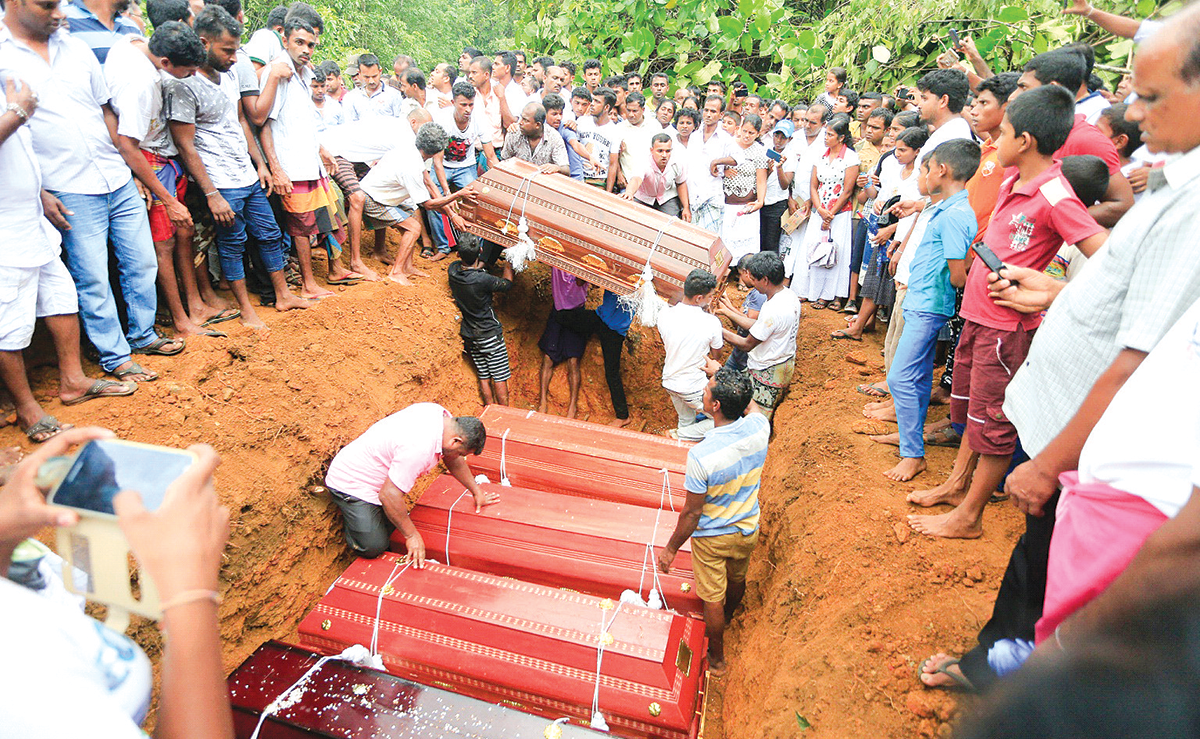
Eighteen Years of Delay:
Cyclone Ditwah has come and gone, leaving a trail of extensive damage to the country’s infrastructure, including buildings, roads, bridges, and 70% of the railway network. Thousands of hectares of farming land have been destroyed. Last but not least, nearly 1,000 people have lost their lives, and more than two million people have been displaced. The visuals uploaded to social media platforms graphically convey the widespread destruction Cyclone Ditwah has caused in our country.
The purpose of my article is to highlight, for the benefit of readers and the general public, how a project to establish a Doppler Weather Radar system, conceived in 2007, remains incomplete after 18 years. Despite multiple governments, shifting national priorities, and repeated natural disasters, the project remains incomplete.
Over the years, the National Audit Office, the Committee on Public Accounts (COPA), and several print and electronic media outlets have highlighted this failure. The last was an excellent five-minute broadcast by Maharaja Television Network on their News First broadcast in October 2024 under a series “What Happened to Sri Lanka”
The Agreement Between the Government of Sri Lanka and the World Meteorological Organisation in 2007.
The first formal attempt to establish a Doppler Radar system dates back to a Trust Fund agreement signed on 24 May 2007 between the Government of Sri Lanka (GoSL) and the World Meteorological Organisation (WMO). This agreement intended to modernize Sri Lanka’s meteorological infrastructure and bring the country on par with global early-warning standards.
The World Meteorological Organisation (WMO) is a specialized agency of the United Nations established on March 23, 1950. There are 193 member countries of the WMO, including Sri Lanka. Its primary role is to promote the establishment of a worldwide meteorological observation system and to serve as the authoritative voice on the state and behaviour of the Earth’s atmosphere, its interaction with the oceans, and the resulting climate and water resources.
According to the 2018 Performance Audit Report compiled by the National Audit Office, the GoSL entered into a trust fund agreement with the WMO to install a Doppler Radar System. The report states that USD 2,884,274 was deposited into the WMO bank account in Geneva, from which the Department of Metrology received USD 95,108 and an additional USD 113,046 in deposit interest. There is no mention as to who actually provided the funds. Based on available information, WMO does not fund projects of this magnitude.
The WMO was responsible for procuring the radar equipment, which it awarded on 18th June 2009 to an American company for USD 1,681,017. According to the audit report, a copy of the purchase contract was not available.
Monitoring the agreement’s implementation was assigned to the Ministry of Disaster Management, a signatory to the trust fund agreement. The audit report details the members of the steering committee appointed by designation to oversee the project. It consisted of personnel from the Ministry of Disaster Management, the Departments of Metrology, National Budget, External Resources and the Disaster Management Centre.
The Audit Report highlights failures in the core responsibilities that can be summarized as follows:
· Procurement irregularities—including flawed tender processes and inadequate technical evaluations.
· Poor site selection
—proposed radar sites did not meet elevation or clearance requirements.
· Civil works delays
—towers were incomplete or structurally unsuitable.
· Equipment left unused
—in some cases for years, exposing sensitive components to deterioration.
· Lack of inter-agency coordination
—between the Meteorology Department, Disaster Management Centre, and line ministries.
Some of the mistakes highlighted are incomprehensible. There is a mention that no soil test was carried out before the commencement of the construction of the tower. This led to construction halting after poor soil conditions were identified, requiring a shift of 10 to 15 meters from the original site. This resulted in further delays and cost overruns.
The equipment supplier had identified that construction work undertaken by a local contractor was not of acceptable quality for housing sensitive electronic equipment. No action had been taken to rectify these deficiencies. The audit report states, “It was observed that the delay in constructing the tower and the lack of proper quality were one of the main reasons for the failure of the project”.
In October 2012, when the supplier commenced installation, the work was soon abandoned after the vehicle carrying the heavy crane required to lift the radar equipment crashed down the mountain. The next attempt was made in October 2013, one year later. Although the equipment was installed, the system could not be operationalised because electronic connectivity was not provided (as stated in the audit report).
In 2015, following a UNOPS (United Nations Office for Project Services) inspection, it was determined that the equipment needed to be returned to the supplier because some sensitive electronic devices had been damaged due to long-term disuse, and a further 1.5 years had elapsed by 2017, when the equipment was finally returned to the supplier. In March 2018, the estimated repair cost was USD 1,095,935, which was deemed excessive, and the project was abandoned.
COPA proceedings
The Committee on Public Accounts (COPA) discussed the radar project on August 10, 2023, and several press reports state that the GOSL incurred a loss of Rs. 78 million due to the project’s failure. This, I believe, is the cost of constructing the Tower. It is mentioned that Rs. 402 million had been spent on the radar system, of which Rs. 323 million was drawn from the trust fund established with WMO. It was also highlighted that approximately Rs. 8 million worth of equipment had been stolen and that the Police and the Bribery and Corruption Commission were investigating the matter.
JICA support and project stagnation
Despite the project’s failure with WMO, the Japan International Cooperation Agency (JICA) entered into an agreement with GOSL on June 30, 2017 to install two Doppler Radar Systems in Puttalam and Pottuvil. JICA has pledged 2.5 billion Japanese yen (LKR 3.4 billion at the time) as a grant. It was envisaged that the project would be completed in 2021.
Once again, the perennial delays that afflict the GOSL and bureaucracy have resulted in the groundbreaking ceremony being held only in December 2024. The delay is attributed to the COVID-19 pandemic and Sri Lanka’s economic crisis.
The seven-year delay between the signing of the agreement and project commencement has led to significant cost increases, forcing JICA to limit the project to installing only one Doppler Radar system in Puttalam.
Impact of the missing radar during Ditwah
As I am not a meteorologist and do not wish to make a judgment on this, I have decided to include the statement issued by JICA after the groundbreaking ceremony on December 24, 2024.
“In partnership with the Department of Meteorology (DoM), JICA is spearheading the establishment of the Doppler Weather Radar Network in the Puttalam district, which can realize accurate weather observation and weather prediction based on the collected data by the radar. This initiative is a significant step in strengthening Sri Lanka’s improving its climate resilience including not only reducing risks of floods, landslides, and drought but also agriculture and fishery“.
Based on online research, a Doppler Weather Radar system is designed to observe weather systems in real time. While the technical details are complex, the system essentially provides localized, uptotheminute information on rainfall patterns, storm movements, and approaching severe weather. Countries worldwide rely on such systems to issue timely alerts for monsoons, tropical depressions, and cyclones. It is reported that India has invested in 30 Doppler radar systems, which have helped minimize the loss of life.
Without radar, Sri Lanka must rely primarily on satellite imagery and foreign meteorological centres, which cannot capture the finescale, rapidly changing weather patterns that often cause localized disasters here.
The general consensus is that, while no single system can prevent natural disasters, an operational Doppler Radar almost certainly would have strengthened Sri Lanka’s preparedness and reduced the extent of damage and loss.
Conclusion
Sri Lanka’s inability to commission a Doppler Radar system, despite nearly two decades of attempts, represents one of the most significant governance failures in the country’s disastermanagement history.
Audit findings, parliamentary oversight proceedings, and donor records all confirm the same troubling truth: Sri Lanka has spent public money, signed international agreements, received foreign assistance, and still has no operational radar. This raises a critical question: should those responsible for this prolonged failure be held legally accountable?
Now may not be the time to determine the extent to which the current government and bureaucrats failed the people. I believe an independent commission comprising foreign experts in disaster management from India and Japan should be appointed, maybe in six months, to identify failures in managing Cyclone Ditwah.
However, those who governed the country from 2007 to 2024 should be held accountable for their failures, and legal action should be pursued against the politicians and bureaucrats responsible for disaster management for their failure to implement the 2007 project with the WMO successfully.
Sri Lanka cannot afford another 18 years of delay. The time for action, transparency, and responsibility has arrived.
(The views and opinions expressed in this article are solely those of the author and do not necessarily reflect the policy or position of any organization or institution with which the author is affiliated).
By Sanjeewa Jayaweera
Features
Ramifications of Trump Corollary
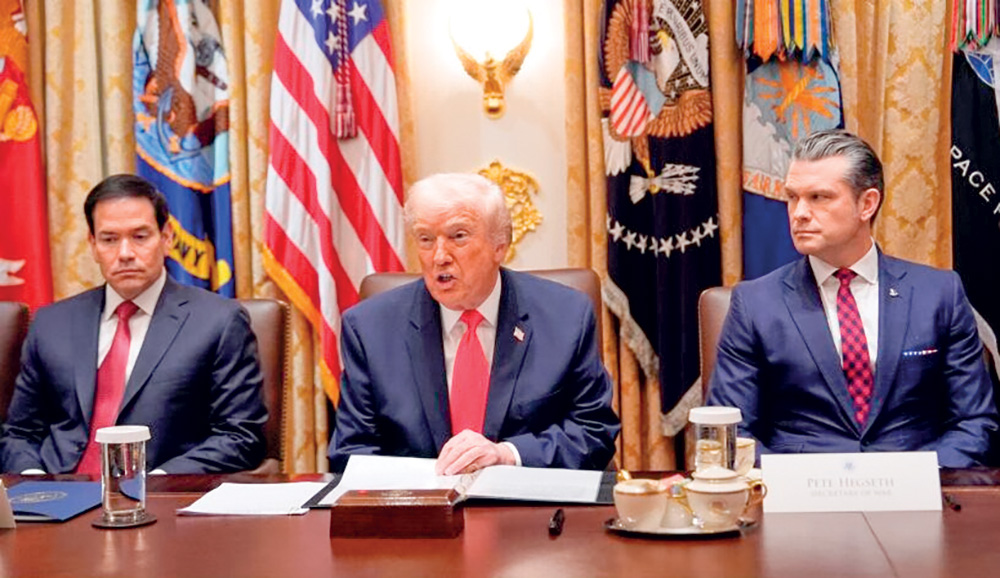
President Trump is expected to close the deal on the Ukraine crisis, as he may wish to concentrate his full strength on two issues: ongoing operations in Venezuela and the bolstering of Japan’s military capabilities as tensions between China and Japan over Taiwan rise. Trump can easily concede Ukraine to Putin and refocus on the Asia–Pacific and Latin America. This week, he once again spilled the beans in an interview with Politico, one of the most significant conversations ever conducted with him. When asked which country currently holds the stronger negotiating position, Trump bluntly asserted that there could be no question: it is Russia. “It’s a much bigger country. It’s a war that should’ve never happened,” he said, followed by his usual rhetoric.
Meanwhile, US allies that fail to adequately fund defence and shirk contributions to collective security will face repercussions, Secretary of War Pete Hegseth declared at the 2025 Reagan National Defense Forum in Simi Valley, California. Hegseth singled out nations such as South Korea, Israel, Poland, and Germany as “model allies” for increasing their commitments, contrasting them with those perceived as “free riders”. The message was unmistakably Trumpian: partnerships are conditional, favourable only to countries that “help themselves” before asking anything of Washington.
It is in this context that it becomes essential to examine the Trump administration’s National Security Strategy, issued last week, in order to consider how it differs from previous strategies and where it may intersect with current US military practice.
Trump’s 2025 National Security Strategy is not merely another iteration of the familiar doctrine of American primacy; it is a radical reorientation of how the United States understands itself, its sphere of influence, and its role in the world. The document begins uncompromisingly: “The purpose of foreign policy is the protection of core national interests; that is the sole focus of this strategy.” It is the bluntest opening in any American NSS since the document became a formal requirement in 1987. Whereas previous strategies—from Obama to Biden—wrapped security in the language of democracy promotion and multilateralism, Trump’s dispenses entirely with the pretence of universality. What matters are American interests, defined narrowly, almost corporately, as though the United States were a shareholder entity rather than a global hegemon.
It is here that the ghost of Senator William Fulbright quietly enters, warning in 1966 that “The arrogance of power… the belief that we are uniquely qualified to bring order to the world, is a dangerous illusion.” Fulbright’s admonition was directed at the hubris of Vietnam-era expansionism, yet it resonates with uncanny force in relation to Trump’s revived hemispheric ambitions. For despite Trump’s anti-globalist posture, his strategy asserts a unique American role in determining events across two oceans and within an entire hemisphere. The arrogance may simply be wearing a new mask.
Nowhere is this revisionist spirit more vivid than in the so-called “Trump Corollary to the Monroe Doctrine”, perhaps the most controversial American hemispheric declaration since Theodore Roosevelt’s time. The 2025 NSS states without hesitation that “The United States will reassert and enforce the Monroe Doctrine to restore American preeminence in the Western Hemisphere.” Yet unlike Roosevelt, who justified intervention as a form of pre-emptive stabilisation, Trump wraps his corollary in the language of sovereignty and anti-globalism. The hemispheric message is not simply that outside powers must stay out; it is that the United States will decide what constitutes legitimate governance in the region and deny “non-Hemispheric competitors the ability to position forces or other threatening capabilities… in our Hemisphere”.
This wording alone has far-reaching implications for Venezuela, where US forces recently seized a sanctioned supertanker as part of an escalating confrontation with the Maduro government. Maduro, emboldened by support from Russia, Iran, and China’s so-called shadow fleet, frames Trump’s enforcement actions as piracy. But for Trump, this is precisely the point: a demonstration of restored hemispheric authority. In that sense, the 2025 NSS may be the first strategic document in decades to explicitly set the stage for sustained coercive operations in Latin America. The NSS promises “a readjustment of our global military presence to address urgent threats in our Hemisphere.” “Urgent threats” is vague, but in practical military planning, vagueness functions as a permission slip. It is not difficult to see how a state accused of “narco-terrorism” or “crimes against humanity” could be fitted into the category.
The return to hemispheric dominance is paired with a targeted shift in alliance politics. Trump makes it clear that the United States is finished subsidising alliances that do not directly strengthen American security. The NSS lays out the philosophy succinctly: “The days of the United States propping up the entire world order like Atlas are over.” This is a direct repudiation of the language found in Obama’s 2015 NSS, which emphasised that American leadership was indispensable to global stability. Trump rejects that premise outright. Leadership, in his framing, is merely leverage. Allies who fail to meet burden expectations will lose access, influence, and potentially even protection. Nowhere is this more evident than in the push for extraordinary defence spending among NATO allies: “President Trump has set a new global standard with the Hague Commitment… pledging NATO countries to spend 5 percent of GDP on defence.”
In turn, US disengagement from Europe becomes easier to justify. While Trump speaks of “negotiating an expeditious cessation of hostilities in Ukraine”, it requires little sophistication to decode this as a form of managed abandonment—an informal concession that Russia’s negotiating position is stronger, as Trump told Politico. Ukraine may well become a bargaining chip in the trade-off between strategic theatres: Europe shrinks, Asia and Latin America expand. The NSS’s emphasis on Japan, Taiwan, and China is markedly sharper than in 2017.
China looms over the 2025 NSS like an obsession, mentioned over twenty times, not merely as a competitor but as a driving force shaping American policy. Every discussion of technology, alliances, or regional security is filtered through Beijing’s shadow, as if US strategy exists solely to counter China. The strategy’s relentless focus risks turning global priorities into a theatre of paranoia, where the United States reacts constantly, defined less by its own interests than by fear of what China might do next.
It is equally striking that, just nine days after Cyclone Ditwah, the US Indo-Pacific Command deployed two C130 aircraft—capable of landing at only three locations in Sri Lanka, well away from the hardest-hit areas—and orchestrated a highly choreographed media performance, enlisting local outlets and social media influencers seemingly more concerned with flaunting American boots on the ground than delivering “urgent” humanitarian aid. History shows this is not unprecedented: US forces have repeatedly arrived under the banner of humanitarian assistance—Operation Restore Hope in Somalia (1992) later escalated into full security and combat operations; interventions in Haiti during the 1990s extended into long-term peacekeeping and training missions; and Operation United Assistance in Liberia (2014) built a lasting US operational presence beyond the Ebola response.
Trump’s NSS, meanwhile, states that deterring conflict in East Asia is a “priority”, and that the United States seeks to ensure that “US technology and US standards—particularly in AI, biotech, and quantum computing—drive the world forward.” Combined with heightened expectations of Japan, which is rapidly rearming, Trump’s strategic map shows a clear preference: if Europe cannot or will not defend itself, Asia might.
What makes the 2025 NSS uniquely combustible, however, is the combination of ideological framing and operational signalling. Trump explicitly links non-interventionism, long a theme of his political base, to the Founders’ moral worldview. He writes that “Rigid adherence to non-interventionism is not possible… yet this predisposition should set a high bar for what constitutes a justified intervention.”
The Trump NSS is both a blueprint and a warning. It signals a United States abandoning the liberal internationalist project and embracing a transactional, hemispherically focussed, sovereignty-first model. It rewrites the Monroe Doctrine for an age of great-power contest, but in doing so resurrects the very logics of intervention that past presidents have regretted. And in the background, as Trump weighs the cost of Ukraine against the allure of a decisive posture in Asia and the Western Hemisphere, the world is left to wonder whether this new corollary is merely rhetorical theatre or the prelude to a new era of American coercive power. The ambiguity is deliberate, but the direction of travel is unmistakable.
[Correction: In my column last week, I incorrectly stated that India–Russia trade in FY 2024 25 was USD 18 billion; the correct figure is USD 68.7 billion, with a trade deficit of about USD 59 billion. Similarly, India recorded a goods trade surplus of around USD 41.18 billion with the US, not a deficit of USD 42 billion, with exports of USD 86.51 billion and imports of USD 45.33 billion. Total remittances to India in FY 2024 25 were roughly USD 135.46 billion, including USD 25–30 billion from the US. Apologies for the error.]
by Nilantha Ilangamuwa
Features
MEEZAN HADJIAR

selfmade businessman who became one of the richest men in the Central Province
I am happy that a book about the life and contribution of Sathkorale Muhamdiramlagedara Segu Abdul Cader Hajiar Mohamed Mohideen better known as Meezan Hadjiar or Meezan Mudalali of Matale [1911—1964] written by Mohammed Fuaji -a former Principal of Zahira College Matale, has now been published by a group of his admirers and relatives. It is a timely addition to the history of Matale district and the Kandyan region which is yet to be described fully as forming a part of the modern history of our country. Coincidentally this book also marks the centenary of Meezan Hadjiars beginning of employment in Matale town which began in 1925.
Matale which was an outlier in the Kandyan Kingdom came into prominence with the growth of plantations for coffee and, after the collapse of the coffee plantations due to the ‘coffee blight’ , for other tree crops . Coffee was followed by the introduction of tea by the early British investors who faced bankruptcy and ruin if they could not quickly find a substitute beverage for coffee.They turned to tea.
The rapid opening of tea plantations in the hill country demanded a large and hardworking labour force which could not be found domestically. This led to the indenturing of Tamil labour from South India on a large scale. These helpless workers were virtually kidnapped from their native villages in India through the Kangani system and they were compelled to migrate to our hill country by the British administration .
The route of these indentured workers to the higher elevations of the hill country lay through Matale and the new plantation industry developed in that region thereby dragging it into a new commercial culture and a cash economy. New opportunities were opened up for internal migration particularly for the more adventurous members of the Muslim community who had played a significant role in the Kandyan kingdom particularly as traders,transporters,medical specialists and military advisors.
Diaries of British officials like John D’oyly also show that the Kandyan Muslims were interlocutors between the Kandyan King and British officials of the Low Country as they had to move about across boundaries as traders of scarce commodities like salt, medicines and consumer articles for the Kandyans and arecanuts, gems and spices for the British. Even today there are physical traces of the ‘’Battal’’or caravans of oxen which were used by the Muslims to transport the above mentioned commodities to and from the Kandyan villages to the Low country. Another important facet was that Kandyan Muslims were located in villages close to the entrances to the hill country attesting to their mobility unlike the Kandyan villagers.
Thus Akurana, Galagedera, Kadugannawa, Hataraliyadde and Mawanella which lay in the pathways to enter the inner territory of the Kings domain were populated by ‘Kandyan Muslims’ who had the ear of the King and his high officials. The’’ Ge’’ names and the honorifics given by the King were a testament to their integration with the Sinhala polity. Meezan Hadjiars’’ Ge ‘‘name of Sathkorale Mohandiramlage denotes the mobility of the family from Sathkorale, an outlier division in the Kandyan Kingdom, and Mohandiramlage attests to the higher status in the social hierarchy which probably indicated that his forebears were honoured servants of the king.
Meezan Hadjiar [SM Mohideen] was born and bred in Kurugoda which is a small village in Akurana in Kandy district. He belonged to the family of Abdul Cader who was a patriarch and a well known religious scholar. Cader’s children began their education in the village school but at the age of 12 young Mohideen left his native village to apprentice under a relative who had a business establishment in the heart of Matale town which was growing fast due to the economic boom. It must be stated here that this form of ‘learning the ropes’ as an apprentice’was a common path to business undertaken by many of the later Sri Lankan tycoons of the pre-independence era.
But he did not remain in that position for long .When his mentor failed in his business of trading in cocoa, cardamoms, cloves and arecanuts and wanted to close up his shop young Mohideen took over and eventually made a great success of it. His enterprise succeeded because he was able to earn the trust of both his buyers and sellers. He befriended Sinhalese and Tamil producers and the business he improved beyond measure took on the name of Meezan Estates Ltd [The scales] and Mohideen soon became famous as Meezan Mudalali – perhaps the most successful businessman of his time in Matale. He expanded his business interests to urban real estate as well as tea and rubber estates. Soon he owned over 3,000 acres of tea estates making him one of the richest men in the Central Province.
With his growing influence Meezan spent generously on charitable activities including funding a water scheme for his native village of Kurugoda also serving adjoining villages like Pangollamada located in Akurana. He also gave generously to Buddhist causes in Matale together with other emerging low country businessmen like Gunasena and John Mudalali.
Matale was well known as a town in which all communities lived in harmony and tended to help each other. As a generous public figure he became strong supporter of the UNP and a personal friend of its leaders like Dudley Senanayake and Sir John Kotelawela. UNP candidates for public office-both in the Municipality and Parliament were selected in consultation with Meezan who also bankrolled them during election time. He himself became a Municipal councillor. The Aluvihares of several generations had close links with him. it was Meezan who mentored ACS Hameed – a fellow villager from Kurugoda – and took him to the highest echelons of Sri Lankan politics as Minister of Foreign Affairs. He was a supporter and financier of the UNP through thick and thin.
Though his premature death at the age 53 in 1965 saved him from the worst political witch hunts under SWRD Bandaranaike who was his personal friend it was after 1970 and the Coalition regime that Meezan’s large family were deprived of their livelihood by the taking over of all their estates. Fortunately many of his children were well educated and could hold on till relief was given by President Premadasa despite the objections of their father’s erstwhile protégé ACS Hameed who surprisingly let them down badly.
It is only fitting that we, even a hundred years later, now commemorate a great self made Sri Lankan business magnate and generous contributor to all religious and social causes of his time. His name became synonymous with enterprise in Matale – a district in which I was privileged to serve as Government Agent in the late sixties.He was a model entrepreneur and his large family have also made outstanding contributions to this country which also attest to the late Meezan Hadjiars foresight and vision of a united and prosperous Srilanka.
by SARATH AMUNUGAMA.
-

 Features4 days ago
Features4 days agoFinally, Mahinda Yapa sets the record straight
-

 News6 days ago
News6 days agoOver 35,000 drug offenders nabbed in 36 days
-

 News5 days ago
News5 days agoCyclone Ditwah leaves Sri Lanka’s biodiversity in ruins: Top scientist warns of unseen ecological disaster
-

 News6 days ago
News6 days agoRising water level in Malwathu Oya triggers alert in Thanthirimale
-
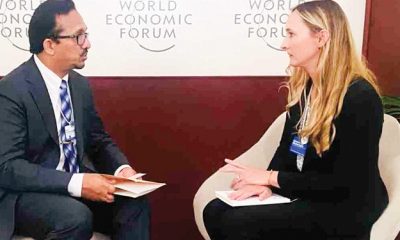
 Features4 days ago
Features4 days agoHandunnetti and Colonial Shackles of English in Sri Lanka
-
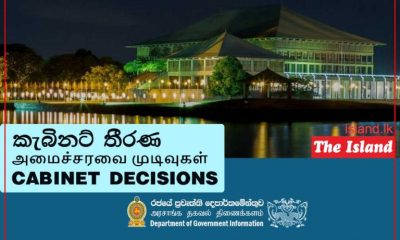
 Business3 days ago
Business3 days agoCabinet approves establishment of two 50 MW wind power stations in Mullikulum, Mannar region
-

 Business6 days ago
Business6 days agoSri Lanka betting its tourism future on cold, hard numbers
-

 News6 days ago
News6 days agoNew landslide alerts as Ditwah aftermath worsens


